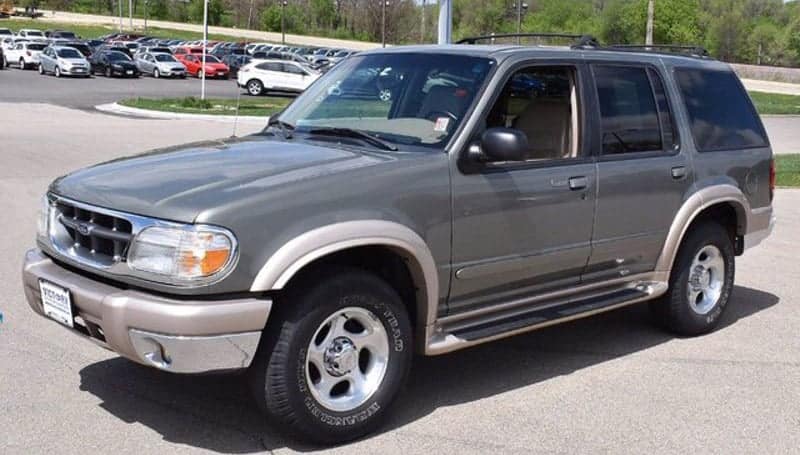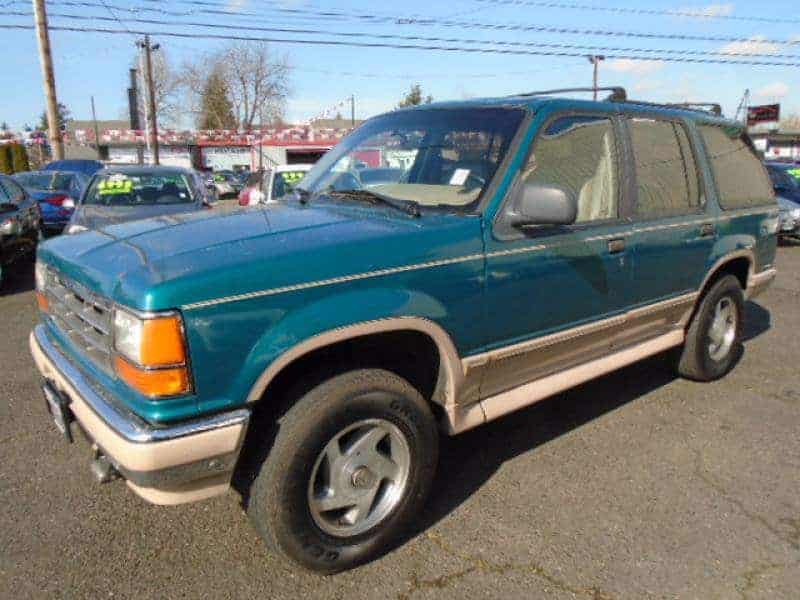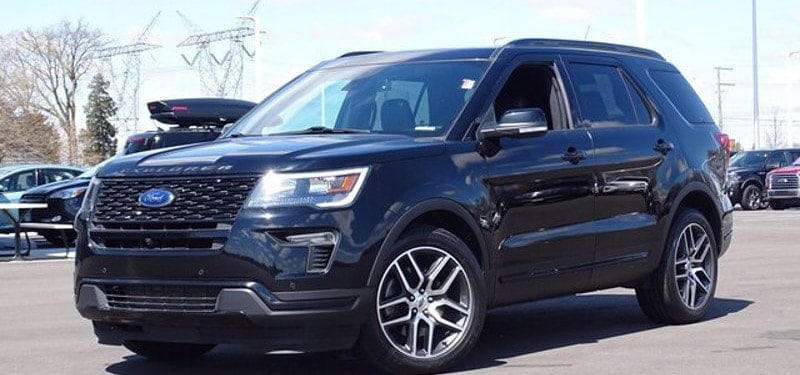What to Look for When Buying a Used Ford Explorer
The Ford Explorer is a vehicle that’s changed a lot over the years. It started out as a two-door compact SUV, then it grew to become a midsize SUV, and since 2010 it’s morphed into a thoroughly modern midsize crossover SUV. Although excellent vehicles, they can get pretty pricey for a non-luxury model when you buy them new, so here’s what you need to look for when buying a used Ford Explorer.

How long has the Ford Explorer been in production?
In 1990 Ford put its first version of the Explorer into production and launched it as a 1991 model year, it’s still in production today, and despite going through some notable changes there’s never been a break in production. Back in those days, it was a two-door compact SUV that followed in the footsteps of the Bronco II but it shared more in terms of looks and components with the Ford Ranger of its day.
Why is the Ford Explorer so popular?
The Ford Explorer has always been popular because it has always been a stylish, comfortable and capable vehicle that always seems to understand what buyers want at the time. The Ford Explorer has always sold well in all its forms, although sales did take a big knock from the 2008 model year until things started to recover dramatically in 2011.
How popular is the Ford Explorer?
When the Ford Explorer first appeared in 1990 it sold an impressive 140,509 units, but even that impressive number was dwarfed a year later when sales of the Explorer more than doubled to 282,837. Sales remained around the same level until 1995 when they fell less than 5,000 units short of the magical 400k mark, but that number was achieved in 1996 before the Explorer had its best sales year ever with 445,157 units sold in 2000.
Sales then fell below 400,000 again in 2003 when they went into a pretty dramatic decline, bottoming out at a miserable 52,190 in 2009. Sales rallied to 135,179 in 2011 and by 2015 the Explorer settled into a steady pattern of delivering around 225,000 units per year.
Even before we get into the details of the different generations of the Ford Explorer, the fact its sales were so poor between 2006 and 2010 should tell you these are model years to be suspicious of if you’re looking to buy a used Ford Explorer.
How many generations of the Ford Explorer are there?

There have been six different generations of the Ford Explorer. The first-generation Ford Explorer was available for the 1991-1994 model years, and a second-generation was a somewhat evolutionary progression for the 1995-2003 model years. Both generations were available in three and five-door variants, but the second-generation five-door Explorer only lasted until 2001 while the three-door carried on until 2003.
The first proper redesign of the Ford Explorer came with the third generation that covered the 2002 to 2005 model year, and this was the first version of the Explorer that wasn’t effectively a Ranger pickup truck with a back on it. Although the third generation retained the availability of four-wheel-drive capability, the exterior was much more station wagon than SUV.
Explorers started to look more SUV-like with the arrival of the fourth generation for the 2006 model year, and this version was built on a new frame and benefitted from a notably updated interior.
This model continued until the 2010 model year and a completely redesigned fifth-generation Ford Explorer arrived for the 2011 model year, which is where the truck-based ladder-frame construction was ditched in favor of a unibody crossover platform instead.
The fifth-generation redesign of the Explorer proved extremely successful and Ford sold more than twice as many fifth-gen models in 2011 as the fourth-generation sold the year before. The fifth generation continued to see sales grow almost every year until it was replaced by a new sixth generation for the 2019 model year.
The sixth generation marks something of a radical shift for the Explorer as it’s now built on a rear-drive platform, and its sporty credentials were further enhanced with the introduction of an ST variant for the first time.

How well does the Ford Explorer hold its value?
A Ford Explorer depreciates by around 32% over the first three years and 36,000 miles, and a five-year-old example with 60,000 miles will have lost approximately 51% of its original sale price. That’s around the same level of depreciation as a Chevy Traverse, although the Traverse will have depreciated by a few percent more than the Ford after five years.
The percentage by which the Ford Explorer depreciates is about par for the course, but it’s a substantial amount of money if you’re considering a high-specification version of the Explorer. That’s why even a slightly used Ford Explorer is a much better value-for-money proposition than a brand new one I think is a little overpriced.
Is the Ford Explorer reliable?
The Ford Explorer is not without its reliability issues and it’s not always the older models that you have to be wary of. The 2002 Explorer is one you probably want to steer clear of but the problems that model had continued to a lesser extent until the 2007 model year arrived. Some of the problems these model years suffered from include:
- Transmission failure
- Heaters sticking on the hottest setting
- A rough idle and stalling
- Cracks in the plastic intake manifold
- Timing chain cassettes cracking
- Bodywork issues
Does the Ford Explorer have transmission problems?
Many vehicles that have been around a long time have transmission problems from time to time, but some models suffer from these issues more than others and it’s one of the main issues you need to look for when checking out any used Ford Explorer.
Those 2002-2007 models can suffer from transmissions that can lunge, jolt, or not engage at all, while others can suffer from the transmission cam slamming into gear which can then cause a shake and an unstable, unreliable shift. Sometimes, if the transmission is shifting quicker than it should do and it’s causing the Explorer to jerk or accelerate quicker than you’d like, it can be down to nothing more than a low fluid level.
Which used Ford Explorer model years should you avoid?
The third-generation Ford Explorers from 2002 to the 2005 model years are probably ones to avoid but 2006 isn’t great either, as it was the first model year of the fourth generation, and the first year of any new generation of a vehicle often suffers from teething problems.
Following on with that theme, there have actually been a lot of problems reported with the 2020 Ford Explorer. As well as not fixing issues of previous models, the 2020 Explorer is reported to have issues with its electronics, power equipment, engine, bodywork, and yes, once again, the transmission.
What’s the fuel economy of the Ford Explorer?
Fuel efficiency isn’t a particularly strong attribute of the Ford Explorer, especially since it became a midsize. Most people reading this will probably be considering a fifth-generation used Ford Explorer because it’s still a modern-looking midsize crossover and it was in production for nine years, so it must have been pretty good, and that’s the one I’ll concentrate on here.
The good news is there’s very little difference between front-wheel-drive and four-wheel-drive versions of the Explorer, but the bad news is the figures are still pretty depressing. The front-drive versions are rated by the EPA at 18 mpg in the city, 25 mpg on the highway, and 20 mpg combined, while the extra capability of AWD changes those numbers to 17/23/19 mpg, respectively.

How many seats in a Ford Explorer?
The Ford Explorer has a maximum seating capacity of seven, although a lot of later models come standard with a reduced capacity of six as they have a pair of captain’s chairs in the second row instead of a bench seat. Either way, the interior of the Explorer is spacious for those inside regardless of whether the Ford has a six or seven-seat capacity.
Is the Ford Explorer AWD?
The Ford Explorer in its standard form is generally front-wheel-drive but various types of four-wheel-drive systems have been available throughout every model year. Later Explorers are offered with a system Ford refers to as its “intelligent 4-wheel-drive” system, which is effectively the same as an intelligent AWD system as it constantly monitors the drivetrain power and distributes the torque to whichever wheel or wheels need it, depending on the road conditions to maximize traction.
How safe is the Ford Explorer?
Ford Explorers are pretty safe vehicles due to the fact they are pretty sizeable SUVs that offer an inherent degree of structural safety for those inside. However, if you were to go purely by the ratings of the crash-test agencies you might not be particularly impressed. While the feds at the NHTSA usually give the Explorer a full five-star rating for overall safety, the IIHS hasn’t been anything like as impressed until recently.
The introduction of the new sixth-generation Ford Explorer with its raft of advanced safety technology features has seen the IIHS award the Explorer Top Safety Pick status, but there are still rivals in the segment that rate higher for overall safety.
Is the Ford Explorer fast?
The Ford Explorer has always been a good performer thanks to some pretty powerful engine options offered over the years, especially the 3.5-liter twin-turbo EcoBoost V-6 of more recent times. With that engine under the hood in ST format, the Ford Explorer can get from 0 to 60 mph in a very impressive 5.2 seconds and boasts a top speed of 143 mph.
Is the Ford Explorer comfortable?
Ford started to get serious about the interior comfort of the Explorer from the fourth generation onwards, and fifth-and sixth-generation models can rival luxury SUVs when it comes to the higher trim levels.
While the seats themselves may not be as comfortable as some rivals, it’s hard to argue with the amount of room you have inside the Ford Explorer interior. Those sitting in the second row of a fifth-gen Explorer have more legroom than they would have in a Honda Pilot or a Chevy Traverse, with the Ford offering 39.8 inches compared to 38.5 inches in the Honda and just 36.8 inches in the Chevy.
There’s also more legroom in the third row of the Explorer than there is in the Honda Pilot, and the Explorer has more headroom throughout the cabin than either the Pilot or the Traverse.

What’s the highest level of Ford Explorer?
The Explorer Sport used to be the most expensive trim level in the fifth-generation lineup, but in 2016 a new Platinum trim level took over as the Explorer flagship model. The ST trim level that was introduced in 2020 ran the Platinum close in terms of price and features, but the sportier slant of the ST still kept it a little less luxurious and a little more affordable than the Platinum.
In 2021, the Explorer went even more upmarket by adding a King Ranch version that’s even more upscale and expensive than the Platinum.
Is a used Ford Explorer worth the money?
A used Ford Explorer is definitely worth the money and represents a much better value purchase than a brand-new one. A new Explorer can get seriously expensive when you get to the higher trim levels and the lower-spec models are the best value. When it comes to a used Explorer, however, the depreciation it’s suffered since it was brand new means higher trims start to look like better value.
How much does a used Ford Explorer cost?
Ford Explorers have been around for so long now that it’s entirely possible to pick one up for less than a thousand dollars, but only if you’re desperate or you’re very handy with a set of wrenches!
You can pick up a decent used fifth-generation Ford Explorer from as little as $6,000, but I’d struggle to recommend anything priced lower than that as it would probably have more than 200k miles on the odometer. And if you fancy a used police Explorer interceptor you can pick a 2013 model up for less than $7,000 on Autotrader or even less at a government auction.
Here’s a table of the average maximum and minimum used prices for Ford Explorers from 2009.
| Model Year | Average Minimum Used Price | Average Maximum Used Price |
| 2009 | $5,700 | $18,888 |
| 2010 | $4,995 | $22,203 |
| 2011 | $7,799 | $20,995 |
| 2012 | $5,877 | $22,411 |
| 2013 | $7,988 | $39,081 |
| 2014 | $10,888 | $26,991 |
| 2015 | $11,488 | $29,999 |
| 2016 | $13,892 | $26,420 |
| 2017 | $16,238 | $42,278 |
| 2018 | $21,324 | $48,550 |
| 2019 | $22,788 | $47,999 |
| 2020 | $23,950 | $55,935 |
Where can you buy the cheapest used Ford Explorers?
Because the Ford Explorer sells in good numbers there are plenty around to choose from in the used market, so shop around for the best value, and don’t be afraid to walk away if a deal seems a little pricey.
The Ford Explorer has been a popular vehicle with the police and various government agencies in recent years, and those well-maintained, often low mileage models come onto the used market regularly.

Should you buy a used Ford Explorer?
If you’re shopping for a midsize crossover SUV with up to seven seats you can do a lot worse than a used Ford Explorer. I wouldn’t really look any earlier than the fourth generation, but a fifth-gen Explorer is the one to go for if your budget will run to it. The fifth-generation Ford Explorer is stylish, spacious, comfortable, and well-equipped, and if you get one with the EcoBoost V-6 engine you’ll also enjoy a healthy dose of performance too.
